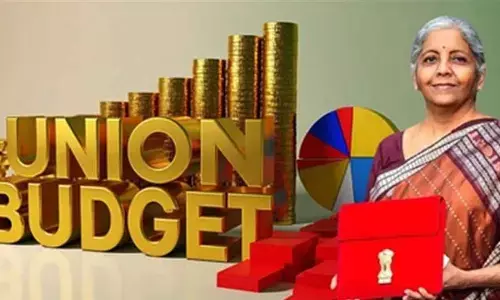AP budget: An exercise of gimmickry
 AP budget: An exercise of gimmickry
AP budget: An exercise of gimmickryThe Andhra Pradesh government presented the budget for the full financial year recently.
For the year 2019-20, as per the revised estimates, total revenue receipts out of all the above sources come to Rs 1,10,000 crore. What is projected for 2020-21 is Rs 1,61,000 crore. After the corona pandemic, everyone is predicting there is going to be contraction by about 5 % to 10% in the GDP. When the overall economy is contracting, it is just beyond one's comprehension how there is going to be so much of a buoyancy in the revenues of the State government. Grants-in aid from the Government of India, which were at Rs 22,000 crore as per the revised estimates during 2019-20 are expected to grow to Rs 53,000 crore during 20-21 more than doubling.
The Andhra Pradesh government presented the budget for the full financial year recently. The same budget presented somewhere in February or March before the Covid-19 pandemic would have been considered highly optimistic and unachievable. Today, as we are going through the pandemic, it looks impossible and nothing more than jugglery of figures. There is an unrealistic estimation of revenue figures to show that incomes match expenditure, that too, not supported by any trends of earlier years.
The main sources of income on the revenue side of the budget are the tax and non-tax revenues of the State government, the share in Central taxes, grants-in aid coming from the Government of India. To this, is added the total borrowings reflected in terms of the fiscal deficit of the State.
For the year 2019-20, as per the revised estimates, total revenue receipts out of all the above sources come to Rs 1,10,000 crore. What is projected for 2020-21 is Rs 1,61,000 crore. After the corona pandemic, everyone is predicting there is going to be contraction by about 5 % to 10% in the GDP. When the overall economy is contracting, it is just beyond one's comprehension how there is going to be so much of a buoyancy in the revenues of the State government. Grants-in aid from the Government of India, which were at Rs 22,000 crore as per the revised estimates during 2019-20 are expected to grow to Rs 53,000 crore during 20-21 more than doubling. Since resources for government of India are going to be precarious due to the effect of the pandemic, the receipts under the grants in aid and Central share of tax revenues are going to be less than what they were in in 2019 -20 or yet best equal to that. The State's own revenues are also not likely to see any great buoyancy. Given the fact that liquor and petrol are the main sources of revenue for the State and since this government has committed itself to a policy of prohibition, any action in that direction is likely to impact the State's own sources of revenue adversely.
Open market borrowings are shown at Rs 54,000 crore as against Rs 49,000 crore for the year 2019-20. The Government of India has relaxed FRBM norm from 3% of GDP to 5% of GDP with some conditionalities. Hence, the State government may not have any problem in doing this additional borrowing.
Given the above budget for 2020-21 realistically may actually be around last year figure of Rs 1,74,000 crores or substantially less than that including the additional borrowings that are being made. Whereas the budget with an estimated spending of Rs 2,24,000 crore presents an additional spending of almost all Rs 50,000 crore. When the resources do not match the expenditure, the expenditure has to be curtailed to match the revenues. The big question is where the axe is going to fall.
In any budget, there are some given expenditures which the government cannot avoid. These are the salaries, pensions, interest payments and repayment of the debts. The amount projected under general services which includes interest payments, pensions and salaries is around Rs 46,000 crore. Debt repayment is around Rs 11,740 crore taking the fixed payments on which nobody has any discretion to around Rs 58,000 crore.
The present Andhra Pradesh government is implementing a number of welfare-oriented schemes transferring funds directly to the bank accounts of the beneficiaries. Summing up of the major schemes displayed on the website of the Finance Department come to Rs 44,000 crore. To this if the massive house site and house building schemes are added up, the projected expenditure is going to be of the order of about a lakh crore rupees. Since there is going to be no buoyancy in the revenue streams during the year, finding money even for these flagship schemes may become a major problem during the course of the financial year leave alone any funds being available for capital expenditure.
Casualty of such an unrealistic budget is going to be putting too much of power in the hands of the bureaucrats in the Finance Department. Since finding funds to run the government on a day-to-day basis becomes difficult number of schemes are going to be squeezed of funds. Essentially, most of the borrowings of about Rs 54,000 crore are going to be used to meet the revenue expenditure further widening the revenue deficit.
A virtual cycle of greater investments, higher growth and greater revenues leading to overall prosperity of the Andhra Pradesh State looks to be a distant dream.
The present Andhra Pradesh government is implementing a number of welfare-oriented schemes transferring funds directly to the bank accounts of the beneficiaries. Summing up of the major schemes displayed on the website of the Finance Department come to Rs 44,000 crore. To this if the massive house site and house building schemes are added up, the projected expenditure is going to be of the order of about a lakh crore rupees. Since there is going to be no buoyancy in the revenue streams during the year, finding money even for these flagship schemes may become a major problem during the course of the financial year leave alone any funds being available for capital expenditure
(The writer is former Chief Secretary of Andhra Pradesh. Views expressed are personal)




